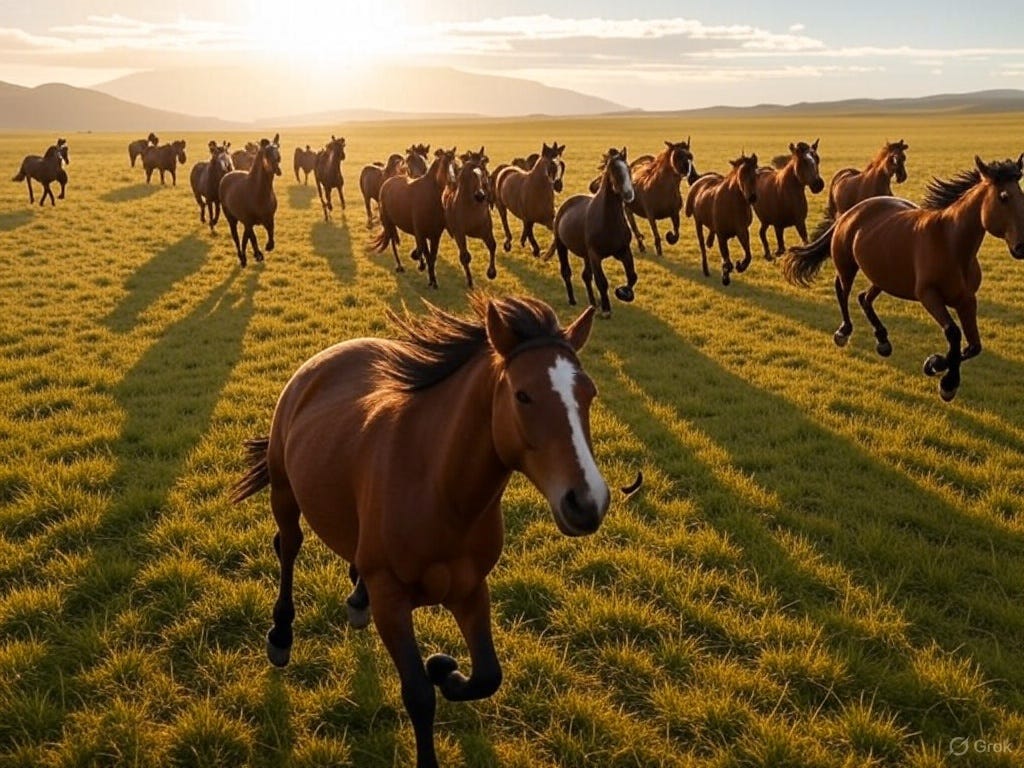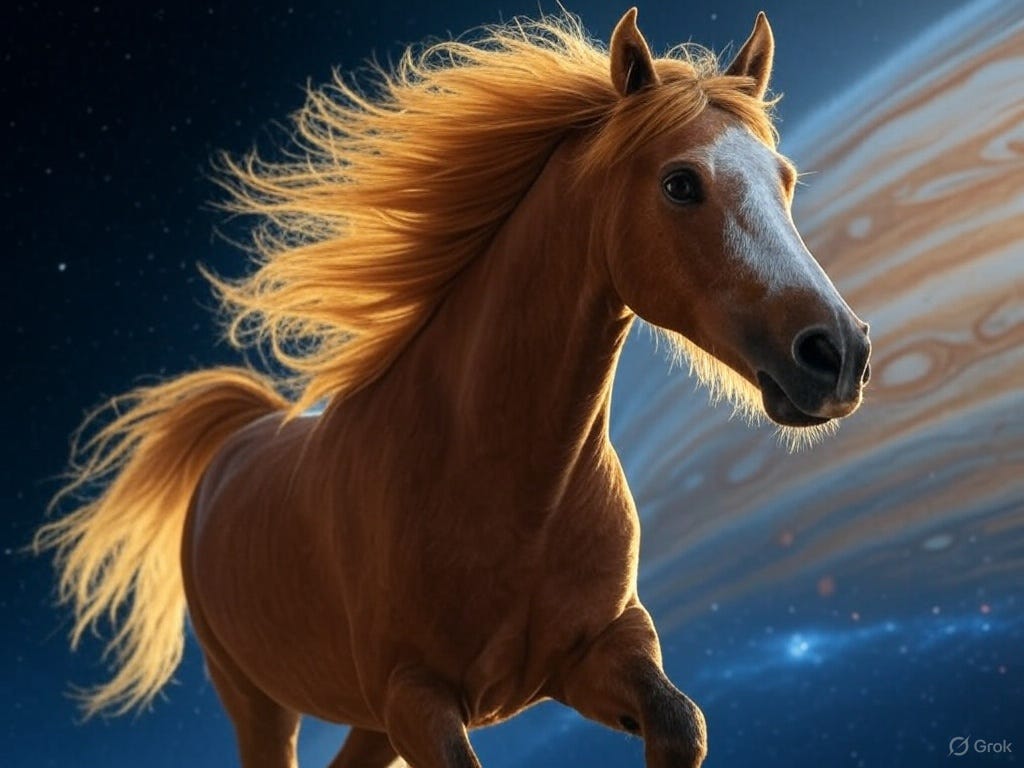TecC 12 - Surmounting Limits: Taming Speed Itself
How mastering motion multiplied mankind’s reach and rewrote human destiny
The last two episodes have chronicled a rather important phenomenon in the history of technology, in the annals of human progress, in the story of how we got to where we are: domestication. The first of the two, agriculture, is however less seen as domestication, though that’s what it is, perhaps because the next one from there, taming animals, is easier to relate to, and certainly more challenging than the relatively lower life forms of plants. Now, let’s get to the very pinnacle of domestication: the horse!
We have already come to appreciate the process of domestication of, well, by definition, a wild animal - such as the wolf into what comes to be known as the dog. And we still have wolves in the wild, still feared by herds of sheep and other domesticated animals, if not their owners, of the predatory nature of these wild beasts. But in cases where we do not have living examples of the wild cousins of a domesticated species, it might be hard to imagine the difference between the docile and the feral variants: but there is a hint, ‘feral’ comes from the same root that gives us ‘ferocious’.
That said, it should still not be hard to imagine the potential ferocity of an animal much bigger than the wolf, whether wild or even a tame one on a bad-hair day. Or should it be a bad-mane day, for I’m of course referring to the horse!
Wild and Free
You might have heard, in history if not amongst your friends and family, of damage or even death to someone on account of being thrown off of a horse. Still, isn’t it astonishing to think that such incidents are relatively rare compared to the collaboration and bond that has existed between horses and humans? I mean would you allow someone else to get on your back and make you go long distances at their will?
So yes, the story of how man tamed this huge beast is harder to tell. I mean, with the wolf, as you saw in the previous episode, it was easy enough: Steve, our Stone-Age friend, threw a piece of freshly cooked meat at a passing-by wolf, and soon they became pals! The horse story is more complex however. Still, let’s try. So enter Bryan, our new friend - because we’re not exactly in the old Stone Age anymore, times have changed!1
So what happened? Bryan was so hungry one day that suddenly he exclaimed “I could eat a horse!”! Well, ok, again, it’s not as frivolous as that, but this alludes to what I mentioned in the previous episode, that many animals started off as sources of meat before becoming domesticated. And the horse is also very likely one such: they were eaten much before they were ridden.2 Archeological research at certain isolated sites in Central Asia going back to 6000 years ago or more suggests horse meat was indeed part of the human diet at that time.3
But let’s take a step back. As I just hinted, it would be quite a challenge to catch a wild horse, forget taking it to win the Derby but even for its meat! compared to say, a sheep or a goat. Before we even get to this, we have to understand the unique evolutionary development of the horse and its habitat.
We know that the horse feeds on grass. Back in the remote mists of evolutionary time, that is to say, going back millions of years, the ancestor of the horse was, because of changes in the climate, exposed to grasslands, as opposed to, say, lush forests. This meant it had to adapt to both getting by eating grass, but also deal with the risk of predators in such open lands with nowhere to hide. This led to some of the features unique to horses, for example, its, well, horsey face - long faces whereby, researchers have explained, it could be feeding on grass while its eyes are still able to spot predators approaching in the distance.
Horse Sense
The eye of the horse, in studies of equine vision, has been said to be one of the largest of any land-based mammal, with an almost full range of vision (350° of which 65° is ‘binocular’, or two-eyed). Think about it, what mammal do you know of that has full panoramic vision, as if tilting the head a full round? This is supplemented by a fairly sophisticated means of communication they possess, but also by their ability to interpret the body language of other species, including us, for predatory intent. Furthermore, horses can sleep while standing,4 another indication of how they evolved to manage the risk of becoming prey in the wide open grasslands as mentioned. But, none of that perhaps is as impressive as that supreme equine feature: running.
Horses, we all know, are great runners! Unlike other great cursorial animals like cheetahs and wolves, horses are running away from predators, they’re not chasing game themselves! (In fact, even humans are great runners having developed our bipedal running technique that reduces mechanical constraints, aided by our improved perspiration mechanism which in fact makes us the best endurance runners5 in the entire animal kingdom!) Nevertheless, horses are made for running - in other words, that’s what they’ve evolved to do well, as demonstrated in their physiology, and in particular their hooves.
But of course, it’s the combination of humans and horses that’s been the most potent. Even if humans can run long distances, that doesn’t include carrying huge amounts of burden. All in all, horses come out better, since they can carry a human and some amount of additional load. So while initially, nomadic peoples cohabiting these beasts in grasslands might have sought horses for their meat, especially given their ability to survive in such conditions unlike sheep and goat,6 they found it compelling to, with all the advantages it gave them which we will later see in further detail, learn to entice and tame these beasts, just as we saw in the previous episode, selecting for the friendlier, more docile ones.7
High Noon
Henry Ford, with reference to his decision to design and build that eponymous contribution of his to modern life, the first widely used vehicle, a machine powered by the combustion engine, is known to have remarked something to the effect of “If I had asked the customers what they wanted, they would’ve asked for a faster horse!”
The motor car, later just car, of course heralded the most significant decline in the use of horses, which were until then ubiquitous members of modern society. But we still have a great amount of horse lore, going beyond Bryan’s hunger-pangs musing: we take the horse to the water, we can’t make it drink; in our politics especially, we still talk about horse trading; when we want to be sure we want to hear it from the horse’s mouth – who knows, it could be a dark horse! All that is, shall we say residual horsepower!
Man’s ability to mount the horse allowed humans to surmount a great many challenges. It enabled certain human groups to go farther and wider, and with mobility came other advantages. We all know stories of glory where alongside human ‘heroes’ are humble horses: in many cases these heroes could hardly have had such claim to herohood without their trusty steed! We have had in the past elaborate notions of say chivalry – literally the notion of a man mounted on a horse, a knight in shining armor, and on and on.
But none of these stories match the most spectacular of them all: a tale of imperishable fame that’s gathered dust since the mists of history, a song of latent legacy needing resung, the most far-reaching of all of our horse-mounted triumphs; one that spans continents, one that stretches millennia, one that lives on in thousands of words we use every single day!
I promise to bring to light this story, in full glory, soon.
And you’ll soon discover how he got that name!
Much to the likely bewilderment of such early peoples to the horse meat scandal that engulfed Britain and neighboring countries around 2013!
Botai, northern Kazakhstan, 5500-5000 BP (before present)
Although they do need to lie down for a couple of hours a day to achieve REM sleep, and in the wild, they do this by taking turns standing and lying down within the herd
There are these ‘Man vs Horse Marathon’ competitions where, while horses start off better, humans have been known to prevail for longer distances and particularly under hot conditions.
Horses can use their hooves to dig through deep snow in winter to reach grass, something these other animals are not capable of
This is said to have happened over the course of probably at least two thousand years with some studies still on-going having only very recently – in the last 5 years, uncovered some startling new data in the field





